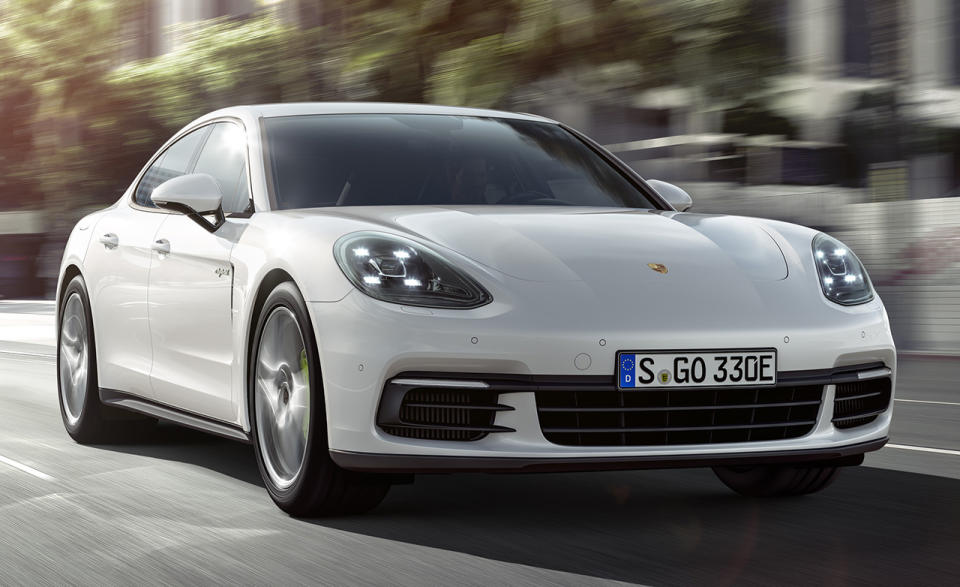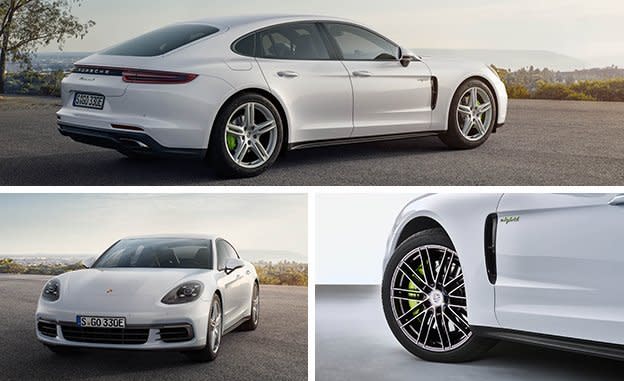2018 Porsche Panamera 4 E-Hybrid: A Fun-to-Drive Plug-In?

Are hybrids fun to drive? For many, the answer is "yes," but the reasons may be different than those given by enthusiasts of traditionally powered cars. Hybrid fans often cite watching the flow of energy in the various displays, slinking through neighborhoods in absolute silence, and enjoying the immediate off-the-line torque enabled by electric motors. The marketplace, however, is sending a different message, especially in the current climate of low fuel prices. But even when fuel was expensive, hybrids from premium brands failed to win hearts—not least because of their sometimes odd driving characteristics.
Porsche is trying to change that with the upcoming plug-in-hybrid version of the new Panamera, the Panamera 4 E-Hybrid, which is slated for a U.S. market launch in mid-2017. To drive home the point of the performance and driving pleasure this car allegedly will offer, Porsche mentions its 918 hybrid supercar no less than five times in the brief press release announcing the latest Panamera derivative. This hybrid, Porsche insists, is fun.

Fitted with an Audi-sourced, Porsche-adapted 330-hp twin-turbo V-6 and a 136-hp electric motor, the Panamera 4 E-Hybrid produces a maximum 462 horsepower and 516 lb-ft of torque. The torque is channeled to all four wheels through a ZF-sourced eight-speed dual-clutch automatic, derived from the gearbox used in conventionally powered Panamera models (and, down the road, in Bentleys that also will use the Panamera’s MSB modular architecture).
The hybrid Panamera can sprint to 62 mph in a claimed 4.6 seconds, and it tops out at 173 mph. That's impressive, but it is slower than the regular Panamera 4S and the Europe-market Panamera 4S diesel, both of which are nominally less powerful than the E-Hybrid. Porsche says the new model needs the electric boost to reach top speed and it needs to be in Sport Plus mode. The company doesn't say how long the E-Hybrid can maintain Vmax.
If the driver keeps a very light foot on the gas pedal, the hybrid can go up to 31 miles on electricity alone, powered by a 14.1-kWh battery pack (up from the previous version’s 9.4-kWh unit) that lives under the rear cargo floor. Maximum speed without the gasoline engine kicking in is 87 mph (although traveling at or near that speed will rapidly deplete the stored electrons). The European cycle for plug-in hybrids, which is of zero relevance to real-life consumption, rates the Panamera E-Hybrid at 94 mpg. (European carmakers are desperate to bring these cars to market because of their strongly positive influence on fleet mileage averages.) A 3.6-kilowatt onboard charger is standard, and a 7.2-kilowatt charger is an option, with the latter lessening charging times to three hours with a 240-volt connection. Using a standard 120-volt outlet means a charging time of 12 hours. Thankfully, there are two modes that save customers the trouble of plugging in to recharge the batteries: The E-Hold setting keeps the charge roughly at a constant level, and E-Charge conveniently but rather inefficiently uses the gasoline engine to recharge the battery pack.

Being green is a lot about image, and to that end, the Panamera 4S E-Hybrid features special green badges and green brake calipers. The neighbors may not be able to hear the Porsche’s powertrain, but these touches will give them the opportunity to duly note your laudable and responsible choice in the upper-luxury executive-sedan segment.
Or you could delete the badges, because they also betray the fact that you’ve taken the cost-conscious route. U.S. pricing has not been announced yet, but in its German home market, the Panamera 4S E-Hybrid is actually less expensive than its 4S (and 4S diesel) sister models. Maybe that cost savings finally will spur buyers to check out the hybrid. But we’re more curious to find out whether it’s any fun to drive. We'll let you know after we've spent time behind the wheel.

 Yahoo Autos
Yahoo Autos 